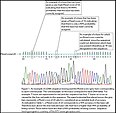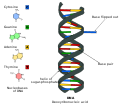components of nucleotides, with all of these monomers constituting the basic building blocks of nucleic acids. The ability of nucleobases to form base pairs and...
15 KB (1,439 words) - 23:17, 7 May 2025
bioinformatics, a single-nucleotide polymorphism (SNP /snɪp/; plural SNPs /snɪps/) is a germline substitution of a single nucleotide at a specific position...
58 KB (6,253 words) - 23:44, 28 April 2025
Nucleotides are organic molecules composed of a nitrogenous base, a pentose sugar and a phosphate. They serve as monomeric units of the nucleic acid polymers...
32 KB (3,305 words) - 14:57, 23 May 2025
Point mutation (redirect from Nucleotide substitution)
A point mutation is a genetic mutation where a single nucleotide base is changed, inserted or deleted from a DNA or RNA sequence of an organism's genome...
39 KB (4,850 words) - 05:57, 9 June 2025
the Human Genome Project. Phred quality scores are assigned to each nucleotide base call in automated sequencer traces. The FASTQ format encodes phred...
13 KB (1,452 words) - 15:41, 13 August 2024
Adenine (redirect from Adenine nucleotides)
Adenine (/ˈædɪniːn/, /ˈædɪnɪn/) (symbol A or Ade) is a purine nucleotide base that is found in DNA, RNA, and ATP. Usually a white crystalline subtance...
13 KB (1,069 words) - 20:54, 18 May 2025
International Union of Pure and Applied Chemistry (category Organisations based in Zurich)
important work IUPAC has done in these fields includes standardizing nucleotide base sequence code names; publishing books for environmental scientists...
55 KB (2,533 words) - 23:55, 30 March 2025
Single-base extension (SBE) is a method for determining the identity of a nucleotide base at a specific position along a nucleic acid. The method is used...
2 KB (252 words) - 15:32, 17 December 2021
(also called an insertion mutation) is the addition of one or more nucleotide base pairs into a DNA sequence. This can often happen in microsatellite...
8 KB (940 words) - 02:53, 25 May 2025
groups. Like other nucleotides, cyclic nucleotides are composed of three functional groups: a sugar, a nitrogenous base, and a single phosphate group. As can...
21 KB (2,416 words) - 02:58, 25 May 2025
Complementarity (molecular biology) (redirect from Complementary base)
other strand, as occurs in the processes of mismatch repair, nucleotide excision repair and base excision repair. Nucleic acids strands may also form hybrids...
23 KB (2,586 words) - 10:40, 20 January 2025
(3) there is no recombination. The term ‘site’ refers to a single nucleotide base pair. Because every new mutation has to occur at a novel site, there...
8 KB (1,000 words) - 02:03, 23 October 2024
Nucleic acid analogue (redirect from Base analog)
the most common base analogs is 5-bromouracil (5BU), the abnormal base found in the mutagenic nucleotide analog BrdU. When a nucleotide containing 5-bromouracil...
49 KB (5,299 words) - 16:59, 25 May 2025
single-nucleotide polymorphism is a modification of a single nucleotide base within a DNA sequence. There are an estimated 15 million SNP (Single-nucleotide...
13 KB (1,573 words) - 04:32, 2 June 2025
wobble base pair is a pairing between two nucleotides in RNA molecules that does not follow Watson-Crick base pair rules. The four main wobble base pairs...
13 KB (1,455 words) - 13:19, 5 October 2024
of the repair pathway for single nucleotide base excision repair. This repair mechanism begins when a single nucleotide is recognized by DNA glycosylase...
4 KB (398 words) - 00:28, 21 September 2023
Arecibo message (section Nucleotides)
vertical bar in the middle is a binary representation of the number of nucleotide base pairs in the human genome. The value depicted is around 4.3 billion...
23 KB (2,418 words) - 14:56, 6 June 2025
suited to the storage of genetic information, while base-pairing between DNA and incoming nucleotides provides the mechanism through which DNA polymerase...
32 KB (3,664 words) - 10:02, 25 May 2025
primarily for removing small, non-helix-distorting base lesions from the genome. The related nucleotide excision repair pathway repairs bulky helix-distorting...
29 KB (3,493 words) - 01:31, 15 January 2025
Deoxyribonucleotide (category Nucleotides)
A deoxyribonucleotide is a nucleotide that contains deoxyribose. They are the monomeric units of the informational biopolymer, deoxyribonucleic acid (DNA)...
2 KB (234 words) - 18:36, 2 May 2022
Mutagen (section Base analogs)
a chemical addition or disruption of a nucleotide base in DNA (generating an abnormal nucleotide or nucleotide fragment), or a break in one or both strands...
51 KB (6,003 words) - 15:54, 19 May 2025
DNA base flipping, or nucleotide flipping, is a mechanism in which a single nucleotide base, or nucleobase, is rotated outside the nucleic acid double...
29 KB (3,308 words) - 05:50, 20 January 2025
frequently in daltons, or as the total number of nucleotide base pairs, usually in megabases (millions of base pairs, abbreviated Mb or Mbp). One picogram...
42 KB (4,897 words) - 20:58, 18 January 2025
Aminoallyl nucleotide is a nucleotide with a modified base containing an allylamine. They are used in post-labeling of nucleic acids by fluorescence detection...
13 KB (1,413 words) - 10:40, 2 April 2025
are the non-sex chromosomes. Chromosome 1 spans about 249 million nucleotide base pairs, which are the basic units of information for DNA. It represents...
47 KB (3,307 words) - 00:15, 1 June 2025
Dideoxynucleotide (redirect from Di-deoxy nucleotide)
the ddGTP, is a pattern observed in various research. That is, each nucleotide base of that particular type has a probability of being bonded to not a...
10 KB (1,181 words) - 03:24, 27 January 2025
Nucleoside triphosphate (redirect from Nucleotide triphosphates)
term nucleoside refers to a nitrogenous base linked to a 5-carbon sugar (either ribose or deoxyribose). Nucleotides are nucleosides covalently linked to...
24 KB (2,518 words) - 06:30, 20 January 2025
Many of these mutations take the form of single nucleotide polymorphisms in which a single nucleotide base is altered compared to a consensus sequence. They...
4 KB (463 words) - 11:21, 17 October 2022
with nitrogenous base, nucleobase, and base pair when referring to the sequences that make up nucleic acids. Compare nucleoside. nucleotide sequence See nucleic...
298 KB (26,436 words) - 06:35, 9 June 2025
nature of DNA, essentially all of the nucleotides take the form of Watson–Crick base pairs between nucleotides on the two complementary strands of the...
19 KB (2,145 words) - 04:24, 14 March 2025






















